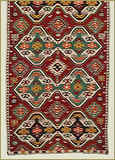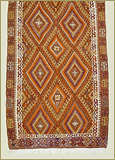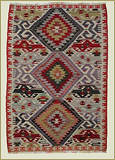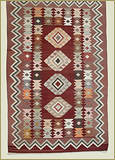| Discover the Treasures of Anatolian Kilims and Other Tribal Rugs
By Stacie Leone
You can’t take home the beautiful tiles of the Blue
Mosque; the dazzling frescoes of the Hagia Sophia are not
for sale, neither are the opulent treasures of Topkapi Palace.
But you can bring home with you a special and truly unique
Turkish memento to treasure for a lifetime: a hand woven
kilim rug.
What is a kilim rug?
 The word Kilim (kill-im), is of Turkish origin
and denotes a pile-less textile produced using
a flat-weaving technique. What distinguishes kilims
from “oriental” or “Persian”
rugs is that they are tightly woven, flat rugs,
while those in the "oriental” rug category
are usually pile rugs and carpets, which are produced
using a knotting technique. Another distinguishing
characteristic of a true kilim rug is that its
design is almost always improvised; the weaver
has the freedom to develop and apply her own design,
color harmony and materials. Oriental rug design,
on the other hand, follows fixed, symmetrical
patterns, and the weaver has no flexibility to
add anything personal to the piece.
The word Kilim (kill-im), is of Turkish origin
and denotes a pile-less textile produced using
a flat-weaving technique. What distinguishes kilims
from “oriental” or “Persian”
rugs is that they are tightly woven, flat rugs,
while those in the "oriental” rug category
are usually pile rugs and carpets, which are produced
using a knotting technique. Another distinguishing
characteristic of a true kilim rug is that its
design is almost always improvised; the weaver
has the freedom to develop and apply her own design,
color harmony and materials. Oriental rug design,
on the other hand, follows fixed, symmetrical
patterns, and the weaver has no flexibility to
add anything personal to the piece.
Long before kilims became decorative items in modern homes,
they were used by tribal communities who created them for
practical purposes such as floor coverings, hangings to
protect from inclement weather or for storage of grains
and other daily essentials. Lightweight and easy to transport,
the kilim was an ideal and essential part of the lives of
nomadic peoples. But, kilims have also long functioned as
much more than practical household items. In fact, each
one tells a story, usually through symbolic images which
differ from region to region. Kilim weavers, often illiterate
in our sense of the word, are wonderfully erudite in the
language of kilim rugs. Girls weaving kilim rugs for their
dowry chests use this language to express their hopes for
children, good fortune or a strong and handsome husband,
while a married woman may show her irritation with a prickly
mother-in-law or longing for an absent mate. Today’s
kilims still incorporate many of these old symbols and are
hand woven in the traditional styles of ancient nomadic
peoples.
 “The
lore of kilim motifs, designs, colors and their
symbolism is as rich and complex as the combined
heritage of cultures that gave them birth,”
says Mr. Can Gurel, the founder of Kilim.com,
an online kilim area rug retail store and information
resource based in Istanbul, Turkey. After graduating
from Harvard University, Gurel started collecting
kilim rugs and has since turned his hobby into
a burgeoning venture with repeat customers from
all over the world. You can visit Kilim.com
to learn about the origins of kilim rugs, the
stories behind their intricate motifs and fascinating
designs, as well as find practical information
such as how to buy a kilim and how to care for
it in your home. Another invaluable resource for
learning all about kilims is a book called “Kilim:
The Complete Guide – History, Pattern, Technique,
Identification”, by Alistair Hull and Jose
Luczyc-Wyhowska, published by Thames & Hudson
and available at most major booksellers. “The
lore of kilim motifs, designs, colors and their
symbolism is as rich and complex as the combined
heritage of cultures that gave them birth,”
says Mr. Can Gurel, the founder of Kilim.com,
an online kilim area rug retail store and information
resource based in Istanbul, Turkey. After graduating
from Harvard University, Gurel started collecting
kilim rugs and has since turned his hobby into
a burgeoning venture with repeat customers from
all over the world. You can visit Kilim.com
to learn about the origins of kilim rugs, the
stories behind their intricate motifs and fascinating
designs, as well as find practical information
such as how to buy a kilim and how to care for
it in your home. Another invaluable resource for
learning all about kilims is a book called “Kilim:
The Complete Guide – History, Pattern, Technique,
Identification”, by Alistair Hull and Jose
Luczyc-Wyhowska, published by Thames & Hudson
and available at most major booksellers.
“Some researchers believe that kilim weaving
originated in Anatolia. Regardless of its origins,
Anatolian kilim rugs are the most varied in their
designs, patterns and motifs because there has
been so much immigration to the country over the
centuries from Central Asia, Caucasus, Iran and
the Balkans. So, shopping for a kilim is actually
more like a great game of exploration and a perfect
way to begin uncovering the rich cultural history
of Anatolia and other kilim producing regions,”
says Gurel.
How to buy a kilim rug
Once you have done a little homework on the subject, experience
the magic of the kilim for yourself by browsing the countless
retailers in the Grand Bazaar and in the Sultanahmet area
of Istanbul. You are likely to find that you learn something
new in each store, which is what makes “kilim hunting”
so much fun. Try to find stores that specialize in kilim
rugs rather than carry them as a small part of their rug
collection. Of course, the best way to select a shop is
through a referral from someone who has shopped there before
and is satisfied with the quality of their kilims and the
service they received. Another great way to learn about
kilims is to visit the Museum of Turkish and Islamic Arts
in Istanbul, which has a wide collection of kilims from
different time periods and regions of Anatolia.
What to pay for a kilim rug
 You
can expect to pay anywhere from €40-250 per
square meter for a new kilim rug. The low end
of this spectrum includes kilims with synthetic
dyed, coarse wool and weaving, while the high
end comprises vegetable dyed kilims made from
handspun wools with fine weaving. You
can expect to pay anywhere from €40-250 per
square meter for a new kilim rug. The low end
of this spectrum includes kilims with synthetic
dyed, coarse wool and weaving, while the high
end comprises vegetable dyed kilims made from
handspun wools with fine weaving.
High-quality synthetic dyes can look as good as natural
dyes when used skillfully, but some prefer the authenticity
and the color harmony of natural dyes. Of course, because
these types of kilims take much longer to produce, they
are more rare and therefore cost from two to four times
more than a synthetic dyed kilim not made from handspun
wool.
Old kilims are priced according to their condition,
rarity, colors, dyes, size and origin, so the
price range is very wide. Antique or collector
pieces are in a category of their own and can
fetch upwards of €50,000 but high-end pieces
are usually only sold at auction houses. For those
on a budget, there are plenty of “non-rug
kilims” and other area rugs and tribal rugs
on offer which make beautiful home or fashion
accessories, including pillow cases, wall hangings,
purses and luggage made from kilim remnants. These
range in price from €10 for a small pillow
case up to a few hundred euros for a leather trim
carry-on suitcase made from pieces of old kilims.
How to bargain
 Before
setting your heart on the kilim that will grace
the walls of your flat back home, be sure to visit
several shops. Once you’ve found a shop
you like, don’t march in and ask “how
much?” Take your time, admire the goods.
Pick a few kilims you like and have the dealer
put them aside for you as you browse. Know the
maximum you are willing to pay, but be sure to
keep that figure to yourself. There are plenty
of friendly people in the business who are open
to bargaining and want to see you return home
with something special from Turkey that you will
cherish for years to come. Do not worry if you
cannot make up your mind when you are in Turkey,
because you can always browse kilims in the comfort
of your home over the Internet and have it delivered
to your door. Before
setting your heart on the kilim that will grace
the walls of your flat back home, be sure to visit
several shops. Once you’ve found a shop
you like, don’t march in and ask “how
much?” Take your time, admire the goods.
Pick a few kilims you like and have the dealer
put them aside for you as you browse. Know the
maximum you are willing to pay, but be sure to
keep that figure to yourself. There are plenty
of friendly people in the business who are open
to bargaining and want to see you return home
with something special from Turkey that you will
cherish for years to come. Do not worry if you
cannot make up your mind when you are in Turkey,
because you can always browse kilims in the comfort
of your home over the Internet and have it delivered
to your door.
Five tips for buying kilims
and other tribal rugs:
- Do your homework: check out www.kilim.com
which contains valuable information about the
history, origins and designs of new and antique
kilim rugs. Or find a good book on the subject.
- Take your time shopping around
- Ask plenty of questions
- Be a firm but friendly bargainer
|